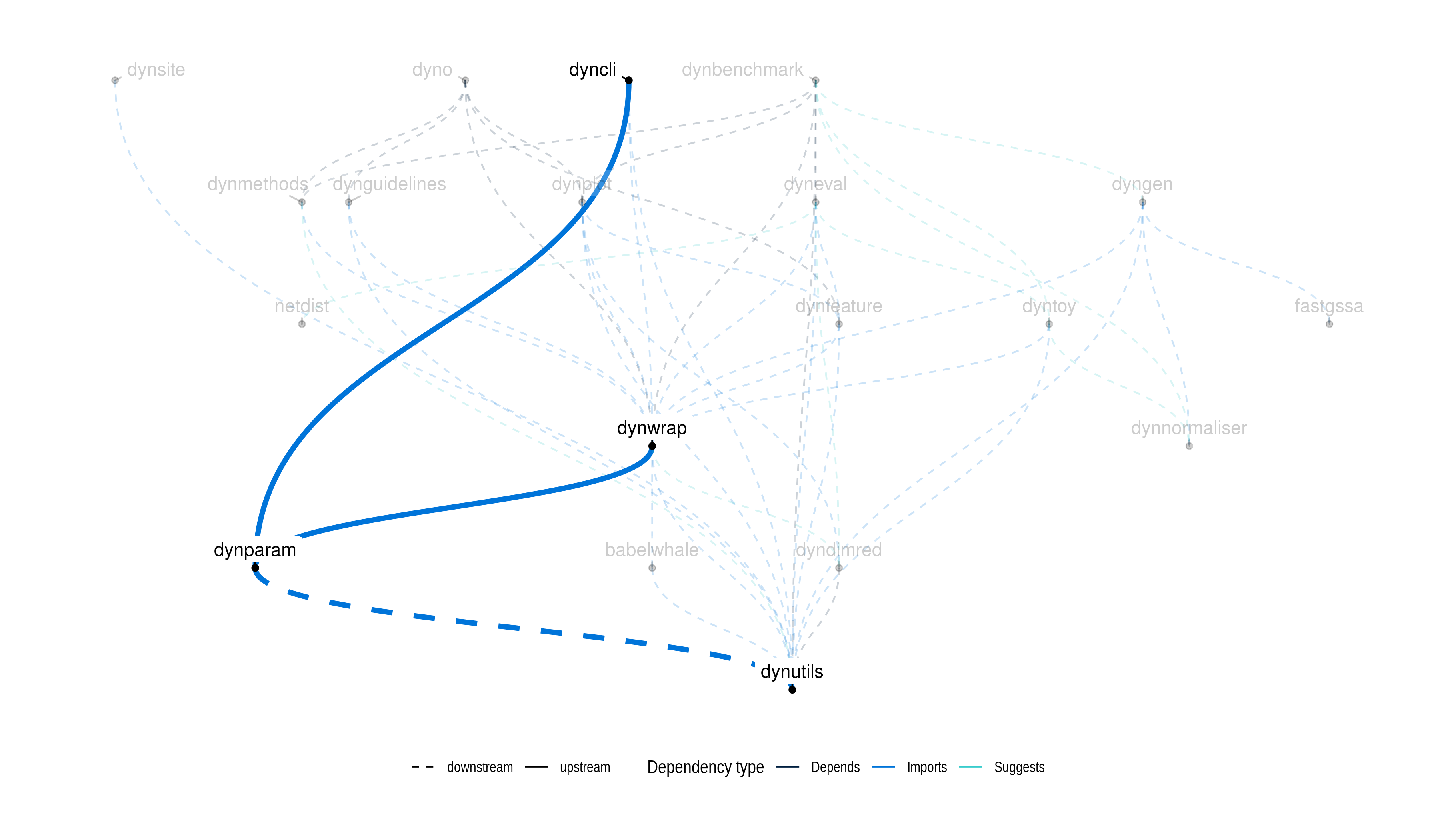
The hardware and bandwidth for this mirror is donated by dogado GmbH, the Webhosting and Full Service-Cloud Provider. Check out our Wordpress Tutorial.
If you wish to report a bug, or if you are interested in having us mirror your free-software or open-source project, please feel free to contact us at mirror[@]dogado.de.
Provides tools for describing parameters of algorithms in an abstract
way. Description can include an id, a description, a domain (range or
list of values), and a default value. ‘dynparam’ can also convert
parameter sets to a ParamHelpers format, in order to be
able to use dynparam in conjunction with
mlrMBO. Check ?dynparam for an overview of all
functionality provided by dynparam.
The main goal of dynparam is to be able to describe a
set of parameters, be able to serialise the parameter sets, and also
sample random settings from the parameter set.
library(tidyverse)
library(dynparam)
set.seed(1)Define a parameter set as follows:
parameters <- parameter_set(
integer_parameter(
id = "num_iter",
default = 100L,
distribution = expuniform_distribution(lower = 1L, upper = 10000L),
description = "Number of iterations"
),
subset_parameter(
id = "dimreds",
default = c("pca", "mds"),
values = c("pca", "mds", "tsne", "umap", "ica"),
description = "Which dimensionality reduction methods to apply (can be multiple)"
),
integer_range_parameter(
id = "ks",
default = c(3L, 15L),
lower_distribution = uniform_distribution(1L, 5L),
upper_distribution = uniform_distribution(10L, 20L),
description = "The numbers of clusters to be evaluated"
)
)You can retrieve the default parameters as follows:
get_defaults(parameters)## $num_iter
## [1] 100
##
## $dimreds
## [1] "pca" "mds"
##
## $ks
## [1] 3 15Serialise a parameter set from/to json/yaml with the
as.list() and as_parameter_set()
functions.
li <- as.list(parameters)
pa <- as_parameter_set(li)Sample a parameter set using with sip():
sip(pa, n = 3)## Loading required namespace: ParamHelpers
## Loading required namespace: lhs
## # A tibble: 3 x 4
## num_iter dimreds ks .object_class
## <int> <list> <list> <list>
## 1 2 <chr [2]> <dbl [2]> <chr [1]>
## 2 2003 <chr [2]> <dbl [2]> <chr [1]>
## 3 5 <chr [3]> <dbl [2]> <chr [1]>parameters <- parameter_set(
integer_parameter(
id = "num_iter",
default = 100L,
distribution = expuniform_distribution(lower = 1L, upper = 10000L),
description = "Number of iterations"
),
numeric_parameter(
id = "delta",
default = c(4.5, 2.4, 1.9),
distribution = normal_distribution(mean = 5, sd = 1),
description = "Multiplying factors"
),
character_parameter(
id = "method",
default = "kendall",
values = c("kendall", "spearman", "pearson"),
description = "Correlation method"
),
logical_parameter(
id = "inverse",
default = TRUE,
description = "Inversion parameter"
),
subset_parameter(
id = "dimreds",
default = c("pca", "mds"),
values = c("pca", "mds", "tsne", "umap", "ica"),
description = "Which dimensionality reduction methods to apply (can be multiple)"
),
integer_range_parameter(
id = "ks",
default = c(3L, 15L),
lower_distribution = uniform_distribution(1L, 5L),
upper_distribution = uniform_distribution(10L, 20L),
description = "The numbers of clusters to be evaluated."
),
numeric_range_parameter(
id = "quantiles",
default = c(0.15, 0.90),
lower_distribution = uniform_distribution(0, .4),
upper_distribution = uniform_distribution(.6, 1),
description = "Quantile cutoff range"
),
forbidden = "inverse == (method == 'kendall')"
)As yaml:
cat(yaml::as.yaml(as.list(parameters)))- id: num_iter
default: 100
description: Number of iterations
tuneable: yes
distribution:
lower: 1
upper: 10000
type: expuniform
type: integer
- id: delta
default:
- 4.5
- 2.4
- 1.9
description: Multiplying factors
tuneable: yes
distribution:
lower: -.inf
upper: .inf
mean: 5.0
sd: 1.0
type: normal
type: numeric
- id: method
default: kendall
description: Correlation method
tuneable: yes
values:
- kendall
- spearman
- pearson
type: character
- id: inverse
default: yes
description: Inversion parameter
tuneable: yes
type: logical
- id: dimreds
default:
- pca
- mds
description: Which dimensionality reduction methods to apply (can be multiple)
tuneable: yes
values:
- pca
- mds
- tsne
- umap
- ica
type: subset
- id: ks
default:
- 3
- 15
description: The numbers of clusters to be evaluated.
tuneable: yes
lower_distribution:
lower: 1
upper: 5
type: uniform
upper_distribution:
lower: 10
upper: 20
type: uniform
type: integer_range
- id: quantiles
default:
- 0.15
- 0.9
description: Quantile cutoff range
tuneable: yes
lower_distribution:
lower: 0.0
upper: 0.4
type: uniform
upper_distribution:
lower: 0.6
upper: 1.0
type: uniform
type: numeric_range
- forbidden: inverse == (method == 'kendall')Generate a random parameter set:
sip(parameters, n = 2)## # A tibble: 2 x 8
## num_iter delta method inverse dimreds ks quantiles .object_class
## <int> <list> <chr> <lgl> <list> <list> <list> <list>
## 1 1823 <dbl [3]> kendall FALSE <chr [3]> <dbl [2]> <dbl [2]> <chr [1]>
## 2 125 <dbl [3]> pearson TRUE <chr [2]> <dbl [2]> <dbl [2]> <chr [1]>Convert paramhelper object:
as_paramhelper(parameters)## Type len Def Constr Req
## num_iter numeric - 0.5 0 to 1 -
## delta numericvector 3 0.309,0.0046... 0 to 1 -
## method discrete - kendall kendall,spearman,pearson -
## inverse logical - TRUE - -
## dimreds integervector 5 1,1,0,0,0 0 to 1 -
## ks numericvector 2 0.5,0.5 0 to 1 -
## quantiles numericvector 2 0.375,0.75 0 to 1 -
## Tunable Trafo
## num_iter TRUE Y
## delta TRUE Y
## method TRUE -
## inverse TRUE -
## dimreds TRUE Y
## ks TRUE Y
## quantiles TRUE Y
## Forbidden region specified.Check out news(package = "dynparam") or NEWS.md for a full list of changes.
check.environment to
FALSE in unit tests to fix breaking changes in R
devel.expect_equal(., ., tolerance = .)
instead of expect_lte(abs(. - .), .) in tests.
These binaries (installable software) and packages are in development.
They may not be fully stable and should be used with caution. We make no claims about them.
Health stats visible at Monitor.